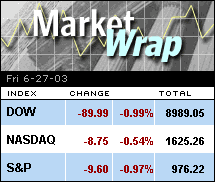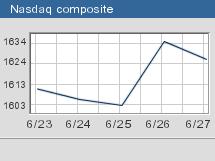NEW YORK (CNN/Money) -
U.S. stocks fell Friday, closing lower on the day and the week, as investors opted to take profits amid weak volume, ho-hum corporate and economic news, and the winding down of the quarter.

The Dow Jones industrial average (down 89.99 to 8989.05, Charts) and the S&P 500 index (down 9.60 to 976.22, Charts) both closed around 1 percent lower, while the Nasdaq composite (down 8.75 to 1625.26, Charts) ended the day down 0.5 percent. The Dow, in particular, suffered a setback as it lost hold of the key 9,000 level.
After more than three months of rallying on the hopes of an economic recovery in the latter part of the year, stocks have been struggling during the past few weeks, just barely eking out weekly gains.
This week marked the first in a month that the major indexes closed lower as a group. The Dow lost 2.3 percent on the week, while the S&P 500 lost just under 2 percent. Both indexes had closed up for the last four weeks. The Nasdaq lost 1.2 percent, after having closed up for three of the last four weeks.
The quarter ends Monday, and it's been largely positive, but as a result, many investors have opted to cash out near its end.
"This has been the strongest quarter in three or four years, and so you'd expect investors to want to take some profits as the quarter is winding down," said Michael Carty, principal at New Millennium Advisors. "As for this week in particular, you saw a lot of people stalling ahead of the Fed decision Wednesday, and the feeling since then is perhaps a little disappointment that more wasn't done, so combine those two factors and you have stocks sliding a bit today."

Wednesday�s Federal Reserve decision to cut the federal funds rate by a quarter-percentage point left some investors disappointed that a more aggressive action wasn't taken. The accompanying statement had a similar impact, as it seemed to offer only a lukewarm assessment of the economy.
Investors spent the past two sessions attempting to better understand the implications of the decision. This has been interspersed with periods of technology-fueled buying and profit taking. On Friday, profit taking won out.
Stocks could be vulnerable to similar skittishness next week, New Millennium's Carty said, as the week is shortened by the Fourth of July holiday and is just ahead of the start of the earnings reporting period.
There are no meaningful quarterly earnings expected next week, but there are a number of economic reports due.
Monday brings the June reading on Chicago PMI, a regional manufacturing survey. It is forecast to show an index of 52.0, down from 52.2 in May.

Tuesday brings auto and truck sales for June, both forecast to be fairly flat compared with May. Tuesday also brings the Institute for Supply Management�s (ISM) June index on manufacturing, which is forecast to have risen to 50.5 from 49.4 the previous month. The report is often a market mover and could be significant if it does come in above 50, which is often seen as a barometer for expansion in the sector.
Because of the holiday Friday, Thursday is very heavy on reports. The ISM reading on the economy's services sector is due and forecast to show a slight rise, while the monthly unemployment rate is forecast to have risen to 6.2 percent in June from 6.1 percent in May. The monthly report on factory orders is expected to show improvement.
Dow leads the decline
Technology shares that have largely led the advance suffered some selling this week and Friday in particular. But they were not alone, with selling in biotechs, financials, homebuilders and various blue chips adding to the declines.
Selling on the Dow was broad, with 26 out of 30 issues closing lower. Traders said the Dow�s struggle was partly technical, as it fell through the 9,000 level and then tried to claw its way back above.
Some of the Dow�s biggest decliners were International Paper (IP: down $0.68 to $36.12, Research, Estimates), which lost 2 percent amid overall weakness in the sector, and Caterpillar (CAT: down $0.93 to $55.83, Research, Estimates), which lost 1.6 percent after smaller rival Agco (AG: down $2.58 to $16.93, Research, Estimates) cut its earnings forecast for the current quarter and full year.
Among other decliners, Honeywell (HON: down $0.56 to $26.69, Research, Estimates) lost 2 percent, while General Electric (GE: down $0.53 to $28.62, Research, Estimates) and Hewlett-Packard (HPQ: down $0.41 to $20.89, Research, Estimates) lost 1.9 percent.
Shares of a number of issues that had rallied over the past few sessions also suffered amid profit taking.
Telecoms, including the NYSE�s most active, Nortel Networks (NT: down $0.12 to $2.73, Research, Estimates), and Dow stocks AT&T (T: down $0.36 to $19.37, Research, Estimates) and SBC Communications (SBC: down $0.59 to $25.44, Research, Estimates) all edged lower.
"The tech leadership we've seen over the past week or so has us a bit baffled, as the issues seem to have gotten a bit ahead of themselves," said Michelle Clayman, chief investment officer at New Amsterdam Partners. "The stocks have been rising so much, they could tap out fairly soon."
Nike (NKE: down $3.85 to $53.08, Research, Estimates) shares tumbled 6.8 percent after the sports shoemaker missed Wall Street's fourth-quarter earnings estimates.
Investors largely shrugged off the morning�s economic reports, amid the influence of all the other factors.
Market breadth was negative. Decliners just barely edged out advancers on both the New York Stock Exchange and the Nasdaq. Volume on the NYSE stood at 1.21 billion shares, and 1.52 billion shares changed hands on the Nasdaq.
Treasury bonds closed little changed, after three sessions of declines. The yield on the 10-year note was 3.54 percent and its price was unchanged at 100-23/32. The dollar was flat versus the euro and slightly weaker versus the yen.
NYMEX light sweet crude oil futures rose 16 cents to $29.27 a barrel. COMEX Gold rose $1.30 to $345.50 an ounce.
European stock markets closed mixed, but shares in Asia closed mostly higher.

|

